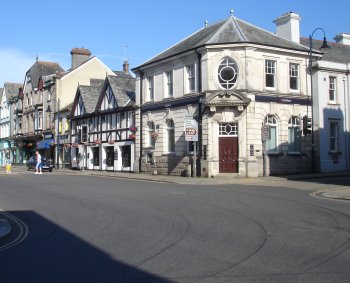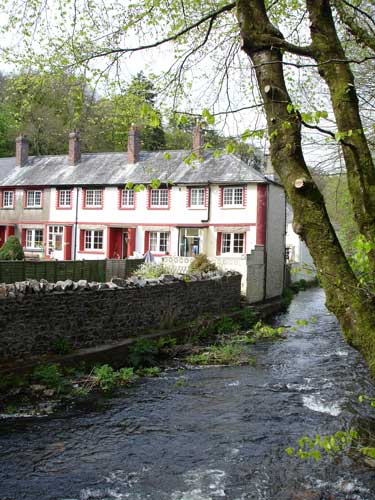In 1086, the Domesday Book records a borough and market at Ochementone near an earlier Saxon settlement. This borough lay where Okehampton lies today, to the north of Dartmoor between the East and West Okement Rivers which meet within the town's boundaries.

In the busy market scene above a crowd of farmers has gathered to mull over the issues of the moment.

Fore Street in the town centre has changed surprisingly little over the last 90 years, but in recent times many new housing developments have sprung up on the periphery, some with exceptionally high density, leading to a rapid increase in population since 1990.


The church at the end of Fore Street is St James which was built as a chantry chapel to All Saints, the parish church which dates back to Saxon times. St James was licensed by the Pope in 1178.



The current All Saints church is the fifth one to be built on the same site. The mediaeval church was destroyed by fire in 1842 and rebuilt in 1844. Only the tower (pictured above) survived the blaze and was incorporated in the current structure. A 13th century grave cover is preserved and is displayed at the entrance.
My earliest memories of Okehampton are not happy ones. Returning from a summer trip by road from my home in Truro to London with my wife and young son in 1970, I recall the traffic on the A30 juddering to a halt on a bend before the steep descent into the town centre. My Morris Minor convertible spluttered and wheezed as we inched forward, stop-go-stop. Eventually we reached Fore Street where a continuous stream of big lorries, cars and charabancs would have been belching out exhaust fumes in the faces of bemused townsfolk throughout the day. Never was there a more dire need for the re-routing of a trunk road.

A bypass was first mooted in 1963, but was not completed until 1988. The planning process involved a protracted debate, including a 96 day Public Inquiry, on whether the route should go through prime agricultural land to the north of the town, or through the northern edge of the Dartmoor National Park to the south. A full account of how the more controversial southern route was finally selected is given here. Whatever the locals may have thought of the chosen route, a report commissioned by the RAC in 1997 found that 80% of residents considered the bypass to be a good thing for Okehampton. There is little through traffic these days, and the roads are not too congested despite the recent expansion of the town.
This pre-1950 Ordnance Survey map shows the old route of the A30 trunk road passing through Okehampton town centre.
Okehampton was not greatly loved by 19th century novelist Charles Kingsley, at least not when seen through the eyes of hero Amyas Leigh in Westward Ho! which is set in the reign of Elizabeth I. However, Amyas and his party were captivated by the sounds of the West Okement river as it hurtled northward down the deep valley from the moor to the town:


Such a derogatory stance is repudiated by other 19th century texts. Here is Black's Guide to Devonshire (1882) describing the scene on entry to the town by train from the east:
Even the townspeople are praised heartily in this extract from Devonshire Sketches: Dartmoor and its Borders, a 1873 publication by the Devon Weekly Times:
To redress the balance I'll let the great Devon scholar WG Hoskins have the last word. From 'Devon' first published in 1954:
